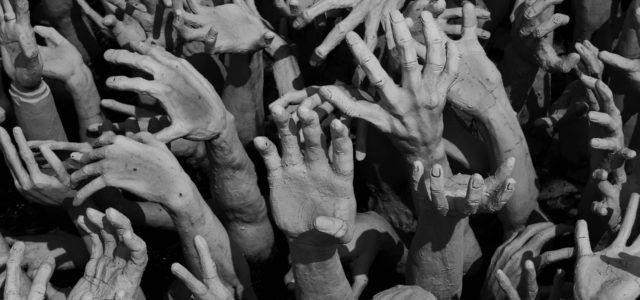In February 2004, Viacom announced that it would spin off Blockbuster Video into its own independent company, which gave its CEO, John Antioco, the opportunity to begin addressing the disruptive threat emanating from Netflix head on. He developed a viable strategy, executed it well, but in the end, his efforts were for nought.
Around the same time, General Stanley McChrystal was tapped to take command of Special Forces in Iraq. Much like Antioco and Blockbuster, he faced a disruptive threat in the form of Al Qaeda that, using unconventional tactics, threatened to thwart his efforts. Unlike Antioco, however, McChrystal succeeded brilliantly.
We tend to think about transformation in terms of strategy and tactics, but if that was all there was to it, Blockbuster would still be thriving today. As I explain in Cascades, the difference between Antioco and McChrystal wasn’t that one had a good plan and the other didn’t, but that McChrystal saw that he had to rewire the networks in his organization.
Why Blockbuster really failed
Today, Blockbuster is a cautionary tale, but for all the wrong reasons. When the spinoff was announced, Antioco moved quickly to build an online rental business and remove the late fees that so many found annoying. Later, in 2006, he created the Total Access program that allowed customers rent DVDs online and return them in stores.
The convenience of the Total Access program was something that Netflix couldn’t match and almost immediately Blockbuster began to surpass Netflix in adding new subscribers. Yet within a few months, a compensation dispute arose between Antioco and the corporate raider Carl Icahn, who had gotten control of the company. Antioco left, the new CEO reversed the strategy and Blockbuster declared bankruptcy in 2010.
The tensions had actually been building for some time. Antioco’s shift to the online business made franchisees, many of whom had their life’s savings tied up in Blockbuster stores, uneasy. The changes were also costly, which depressed earnings and made investors and analysts sceptical. The stock price cratered.
It was the low stock price that led Icahn to buy up stock in Blockbuster, a proxy fight that allowed him to take control of the company’s board, the compensation dispute, Antioco’s departure and the reversal of the strategy. What really killed Blockbuster wasn’t external competition, but internal opposition.
Addressing the internal struggle
While Antioco framed the challenge Blockbuster faced largely in terms of strategy and tactics, McChrystal saw his task as an internal struggle. His forces were among the best in the world and were winning every battle. Yet somehow, they were losing the war and losing it badly.
As McChrystal would later write, “the world had outpaced us. In the time it took us to move a plan from creation to approval, the battlefield for which the plan had been devised would have changed. By the time it had been implemented, the plan—however ingenious in its initial design—was often irrelevant.”
So instead of trying to come up with better plans, McChrystal sought to change how his organization functioned. The problem, as he saw it, was one of interoperability. His forces needed not only to work with each other, but also partner agencies and other stakeholders, in order to succeed.
“I needed to shift my focus from moving pieces on the board to shaping the ecosystem,” McChrystal would remember. The moves paid off. The tide of the war soon shifted and the forces under his command would achieve their major objectives.
Rewiring networks
The main difference between Antioco and McChrystal had less to do with their actions than it did with their mindsets. Where Antioco saw his task in terms of planning and execution, McChrystal saw his in terms of connection. “We began to make progress when we started looking at these relationships as just that: relationships— parts of a network, not cogs in a machine or outputs and inputs,” he would later write.
Antioco would take a very different approach. He set up the Blockbuster Online team in a warehouse down the street its Dallas headquarters. That allowed him to pursue the online strategy with little disruption to operations in the core business, but it also allowed suspicion and fear to fester and grow.
McChrystal, on the other hand, moved to forge links anywhere he could. He started embedding intelligence analysts into commando teams and vice versa. Liaison officer positions, traditionally given to marginal performers or those nearing retirement, were now earmarked for the very best operators.
Moves like these slowed down the individual teams — commandos in business suits placed at embassies don’t kill many terrorists — but that wasn’t the point, building networks of trust and interoperability was. Over the next few years, the effectiveness of his organization improved markedly and overall operating efficiency improved by a factor of seventeen.
Rethinking leadership for a networked age
To a large degree, the most important difference between Antioco and McChrystal was how they saw their role as leaders. Antioco was truly a brilliant strategist and had built an enormously successful career devising effective plans and driving efficient execution. He had encountered opposition before, but had always been able to prevail by showing results.
McChrystal came to see things differently. “I began to reconsider the nature of my role as a leader,” he would later write. “The wait for my approval was not resulting in any better decisions, and our priority should be reaching the best possible decision that could be made in a time frame that allowed it to be relevant.
In other words, where Antioco saw a vertical hierarchy for carrying out tasks efficiently, McChrystal saw a horizontal network of connections which needed to be cultivated. Where Antioco built a strong senior management team to drive his strategy, McChrystal forged shared values throughout his organization so that units could act independently.
The truth is that we need to reimagine leadership for a networked age to focus less on driving strategy and tactics and more on widening and deepening connections in networks. Or, as McChrystal put it, “The role of the senior leader was no longer that of a controlling puppet master, but that of an empathetic crafter of culture.
Article by channel:
Everything you need to know about Digital Transformation
The best articles, news and events direct to your inbox







